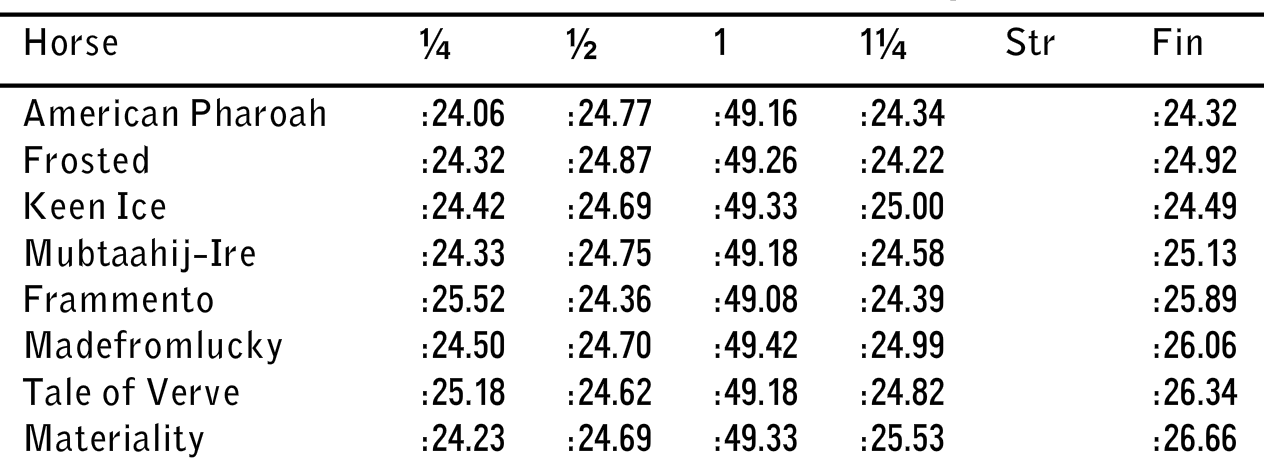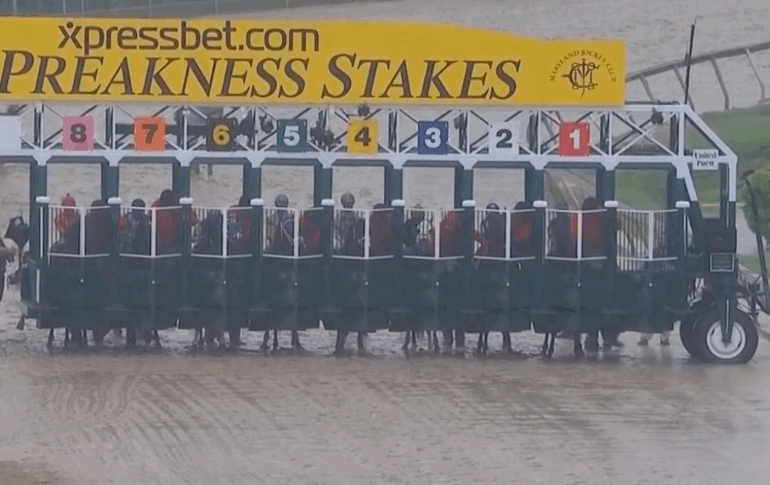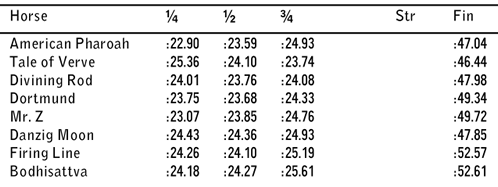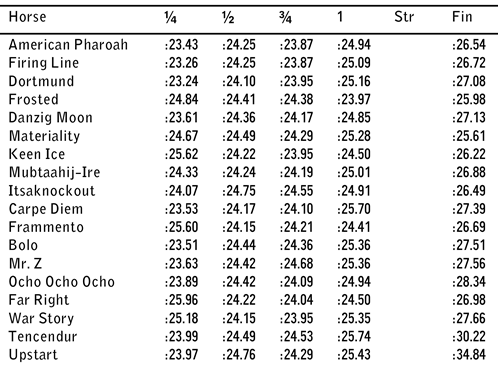Speed Figures

The crowd at Belmont Park celebrates. Credit: Chelsea Durand/NYRA
The Triple Crown winner isn’t sticking around — New York, at least. American Pharoah met the media, charmed the “TODAY” show audience, and boarded a van leaving Belmont Park around 7:30 AM, arriving back at Churchill Downs by 1:30 PM, less than 19 hours after he won the Belmont Stakes and became the 12th Triple Crown winner in American racing, the first in 37 years.
The first in 37 years.
Like a lot of horse racing fans, I don’t remember the last one. I’m not quite sure what to do with this one. He’s marvelous! It’s wonderful! The minutes before the race were nerve-wracking, the seconds it took him to cross the wire — 5 1/2 lengths ahead of runner-up Frosted — thrilling.
There is satisfaction in discovering that a Triple Crown is still possible.
“After seeing what we saw on Saturday,” writes Jason Gay, “can we all agree that stubborn old horse racing had this the right way all along?”
The Triple Crown just needed a racehorse who could take one of the hardest things we ask a young horse to do and make it look easy.
American Pharoah completed the 1 1/2-mile race in 2:26.65, and he did it by going to the lead and reeling off steady :24 quarters, running the first half in :48.31, the first six furlongs in 1:13.41, and the first mile in 1:37.99:

DRF incremental times above. View the official Equibase chart (PDF).
He was never pushed, never threatened. Materiality, tasked with keeping the 3-5 favorite honest on the front, was out of contention before the mile. Frosted looked like a challenger at the top of the stretch — for a stride. American Pharoah gave him no ground. He was going to get away with it all.
“I’m telling you,” said jockey Victor Espinoza afterwards, “in the first turn it was the best feeling I’ve ever had.” Watch the replay:
The 12th Triple Crown winner was given a Beyer speed figure of 105 for the Belmont Stakes. TimeformUS gave him a speed figure of 128. His figures are as consistent as his fractions — American Pharoah’s Preakness and Kentucky Derby Beyers were 102 and 105, his TFUS numbers 125 and 127.
Trainer Bob Baffert reported on Sunday morning that American Pharoah came out of the Belmont in good shape. “Looking at the horse today, he looked pretty darn good for a horse that just ran a mile and a half,” said Baffert. “He’s a tough horse. Today he looked like he could run back in three weeks.”
Per the NYRA press office notes, the plan is for the colt to race again:
“After we freshen him up, we have options,” said Baffert, who mentioned the Grade 1 Haskell Invitational at Monmouth, the Grade 2 Jim Dandy and the Grade 1 Travers Stakes at Saratoga Race Course, and a “little race” at Del Mar, most likely the Grade 1 Pacific Classic.
Jay Privman explains why he believes the Pacific Classic is likely: “it would certainly be an endorsement by Zayat of the return to dirt at Del Mar to run there this summer, and there’s no bigger ‘get’ right now than American Pharoah, who — remember — hasn’t raced in California this year. Yet.”
The Breeders’ Cup Classic at Keeneland is the goal for his final career start.
Recaps! Tim Layden recounts the Belmont Stakes and the weeks before, when the word chingon became code for the confidence of the American Pharoah camp … Joe Drape captures the moment the Triple Crown became real to the 90,000 at Belmont Park … Brendan Prunty writes about the build-up.
More recaps and reactions are bookmarked on this page; I’ll be adding to it.

Sealed, opened, soaked: The condition of the Pimlico track surface became the X factor in the Preakness Stakes when a torrential downpour turned the dirt to mud minutes before post time on Saturday. If anything, the rain was a boon to the 4-5 favorite, already a winner on a wet track. But nothing can be taken for granted in a Triple Crown race: “I took a chance and sent him as quick as I can,” said rider Victor Espinoza, explaining how he hustled American Pharoah from stall #1 and into the lead from the start, outmaneuvering jockey Martin Garcia and stablemate Dortmund, in stall #2, at the break.
American Pharoah won the 1 3/16-mile race by seven lengths in a final time of 1:58.46, “the slowest for the Preakness since 1956, when Fabius was the winner over Needles and No Regrets on a fast track in 1:58 2/5.” Here are the individual fractions from the Daily Racing Form chart:

The winner’s split for the mile was :26.32, and for the final 3/16ths, :20.72 (both those numbers from the official Equibase PDF chart). So, American Pharoah slowed down at the end after a quick opening quarter, and I’m inclined not to read too much into what’s 1) a typical race shape for dirt routes, 2) a pretty good example of what we mean when we talk about tactical speed (see, not only the break, but the way American Pharoah draws away from the others rounding into the stretch), and 3) a finish without challenge (Dortmund checked out, Mr. Z tired out, and Firing Line never fired) over slop.
Jay Privman reports that American Pharoah earned a Beyer speed figure of 102. TimeformUS’ figuremaker gave him 125. He was awarded figures of 105 and 127, respectively, for winning the Kentucky Derby.
“I’ve never won this race as easily and handily,” said trainer Bob Baffert after. The ease does seem almost supernatural, or maybe that’s just the rain:
https://www.youtube.com/watch?v=SxXQASkvBjI
American Pharoah’s Preakness win was the sixth for Baffert; his Belmont Stakes start will be the trainer’s fourth shot at a Triple Crown, the third for Espinoza.
“It’s hard for me to imagine I’m going through this again,” the trainer told the NYRA press office on Sunday morning, and quipped that he’d like a fast track at Belmont. “Like the one Secretariat had. I’ll take that.”
The Belmont Stakes is June 6, and there are currently eight likely contenders, in addition to American Pharoah, including Preakness runner-up Tale of Verve, Peter Pan winner Madefromlucky, and Kentucky Derby runners Frosted, Materiality, Keen Ice, Carpe Diem, Frammento, and Mubtaahij.
British bookies are taking bets — Ladbrokes has Pharoah at even money.
1:15 PM Addendum: American Pharoah was the only horse to gallop back without a mud mask, thanks to his gate-to-wire run, but he was carrying a little extra water weight via Espinoza’s boots.
How’s this for a coincidence? Both the Kentucky Oaks and Kentucky Derby winning trainers omni-ed (finished first and third) in their races, Larry Jones with Lovely Maria and I’m a Chatterbox on Friday, Bob Baffert with American Pharoah and Dortmund on Saturday. And what a story it would have been had 52-year-old jockey Gary Stevens, second in the Derby with Firing Line, been Oaks-winning 56-year-old rider Kerwin Clark’s counterpart.
Sometimes the angle on both classics is upset and surprise; this year it was about being at the top of your game. Form held, in that the Kentucky Oaks winner, yet again, passed through the Fair Grounds. And in that the Kentucky Derby winner was the post-time favorite for the third year running. The Oaks win was the third for Jones since 2008, all with fillies owned by Brereton Jones. The Derby win was the fourth for Baffert, and for an owner, Ahmed Zayat, with a string of near-misses, including one in 2009 with the sire of this year’s winner. For Clark, the Oaks winner was his first Grade 1-winning mount, and the rider was the third to get his first Grade 1 win on one of Jones’ Oaks fillies. For Victor Espinoza, the Derby winner was his third, his second in two years.
“For me to get this opportunity at this time in my life when 15 years ago I had decided I was just going to stay in Louisiana and finish my career out there and just disappear quietly into the sunset,” mused Clark, “I got lucky.”
Espinoza knows the thrill. “I feel like the luckiest Mexican on Earth,” he exulted when Donna Brothers rode up for his first post-race interview, and then he praised his horse. “[American Pharoah] has been a special horse since the first time I rode him. He has a lot of talent and is an unbelievable horse.”
Talent enough to win the Triple Crown? We’ll find out over the next five weeks. Baffert said the plan is — of course — to continue on to the Preakness. His stablemate will do the same. “If Dortmund turns the tables on [American Pharoah], so be it,” the trainer told Jonathan Lintner of the Courier-Journal.
Such equanimity. He can allow himself that after getting both to Churchill Downs and winning with Pharoah. “I’m just relieved, very relieved,†Baffert said to DRF correspondent David Grening (subscription only):
“You know coming in here you got that kind of horse, and he showed it today. Pharoah probably didn’t run as well as he can, but he’s such a good horse. I’m just glad he got through here.â€
American Pharoah was given a Beyer speed figure of 105 for the Kentucky Derby, the same figure he earned winning his final prep, the Arkansas Derby. TimeformUS awarded him 127 (post updated to included this link 5/7/15).
Fractions for the Kentucky Derby from the Daily Racing Form chart:

Looking at the chart, it’s striking how consistent the top three finishers were through the first six furlongs. It’s a very even race. Dortmund (the leader, as predicted by the TimeformUS pace projector) took the field through a moderate first quarter in :23.24, a half in :47.34, and the first three-quarters in 1:11.29, and what had been a tight group near the front the first time past the grandstand separated into the three front-runners and the rest by the final turn. For a nice illustration of how the race unfolded, compare the official chart (PDF) points of call with the Blood-Horse pictorial race sequence.
Watching the replay, what’s most noticeable is how wide American Pharoah is turning into the stretch. Trakus has him covering 29 more feet than Firing Line and 69 more than Dortmund. Minor ground loss doesn’t seem like a bad trade for such an easy trip — the winner was unimpeded all the way around:
The final time for the Derby was 2:03.02, and American Pharoah’s margin at the wire one length over Firing Line. Espinoza had to go to work on him with hands and whip (something Larry Collmus picked up in his call, noting Pharoah was “under a ride”), and he responded. It wasn’t a brilliant victory, but a solid win, the kind that reveals a horse’s mettle. Pharoah is tough.
For that matter, so is Firing Line, who I unfairly and wrongly (so wrongly) discounted when handicapping. The Sunland Derby winner had finished second to Dortmund in their two earlier meetings, and the pair went to the front together in the Kentucky Derby, keeping both busy. “I not only have to turn the tables on Dortmund with Firing Line, but I’ve got to figure out a way to beat American Pharaoh,” Stevens said during a Reddit AMA two weeks ago, talking about his Derby strategy. “I’ve already figured out a way to beat Dortmund! For my plan to work, I’ve got to be in the right place at the right time.” Credit the rider with pulling off at least half his plan — Firing Line headed Dortmund turning into the final quarter and finished two lengths ahead of the previously undefeated colt. If Firing Line did anything wrong, it was that he didn’t switch leads in the stretch (via @randy_moss_TV).
No excuse for Dortmund — he just didn’t have that last furlong in him. Frosted ranged up late and almost got him for show. “He’s a really good horse and he ran like it today,” said jockey Martin Garcia after the Derby. “He always comes to run; that’s the kind of horse he is. He got beat today by really good horses. That can happen.” The question going forward is, did he reveal a distance limitation, or — with the experience — will he be able to handle 10 furlongs in races such as the Travers or Breeders’ Cup Classic?
Back to the Kentucky Oaks: Lovely Maria earned a Beyer speed figure of 94; TimeformUS gave her 105. She drew away for a 2 3/4 length win (PDF):
Her victory is lovely, for so many reasons.
Odds and ends: American Pharoah is a handsome animal … that was quite a Derby winner’s circle celebration … “justice of sorts in Pharoah’s win.”
Copyright © 2000-2023 by Jessica Chapel. All rights reserved.